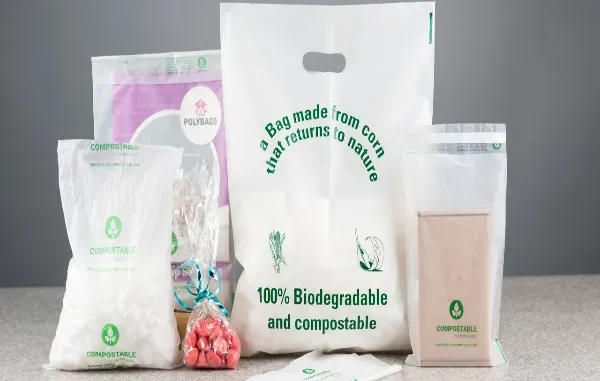

Plastic has long been the workhorse of global supply chains. Lightweight, cheap, versatile, and durable, it has enabled mass distribution of consumer goods, fresh food, pharmaceuticals, and more. But those very qualities—durability and resistance to degradation—are exactly what have made plastic a global environmental problem. As sustainability concerns grow and regulatory pressure increases, compostable packaging is emerging as a powerful alternative that’s reshaping supply chains worldwide.
Why the shift is happening
Several forces are driving the shift from traditional plastic to compostable alternatives:
- Consumer demand: More consumers are choosing brands that are eco-friendly. Products with compostable, biodegradable, or at least recyclable packaging are increasingly preferred. Reports show that people are willing to pay a premium for packaging that aligns with environmental values.
- Regulatory pressure: Governments around the globe are tightening rules on single-use plastics, plastic waste, and packaging disposal. For instance, the EU has directives banning certain single-use plastic items; many countries require packaging to be recyclable or compostable. Companies need to comply or risk fines, bans, or loss of market access.
- Environmental urgency: Plastics contribute to pollution, greenhouse gas emissions, and landfill overload. Compostable materials can help reduce these impacts when sourced, used, and disposed of properly. They offer a way to close loops in supply chains by returning material to soil under controlled composting or industrial composting systems.
- Cost pressures & operational efficiencies: While compostable materials often have higher upfront cost, there are savings elsewhere—lower disposal fees, lighter weight (lower transportation emissions), better brand value, less regulatory risk, and potentially fewer costs from environmental damage or reputational harm.
What compostable packaging is, and its key types
To understand how the change works, it helps to know what compostable packaging means, and how it differs from biodegradable or “bioplastic”:
- Compostable means the material breaks down under composting conditions (industrial or sometimes home composting), returning to biomass, CO₂ and water, without leaving harmful residues.
- Biodegradable is broader; many materials are technically biodegradable but may take too long or need very specific conditions to break down properly.
- Bioplastics are plastics made from biological feedstocks (plants, agricultural waste, etc.), but not all bioplastics are compostable. Some are durable or mix with other non-compostable materials.
Some common compostable materials include PLA (polylactic acid), PHA (polyhydroxyalkanoates), starch-blended films, compostable paper and fiber (e.g. bagasse, sugarcane fiber), and compostable coatings. These materials are used increasingly in food packaging, shipping materials, disposable tableware, and protective packaging.
How compostable packaging is changing global supply chains
Here are some of the transformations underway, as compostable packaging becomes more integrated.
- Material sourcing and supplier collaborationCompanies are rethinking where their packaging materials come from. Instead of relying on petroleum-based plastics, more supply chains are sourcing plant-based feedstocks. This requires partnerships with agricultural producers, investments in feedstock processing, and transparent supply chain tracking to ensure sustainability. Supply chain resilience is improved when feedstocks are more locally sourced.
- Design and logistics optimizationCompostable materials often allow lighter weight and more flexible packaging designs. Optimizing design to use less material, reducing packaging volume, improving stacking, and simplifying component parts helps reduce costs in shipping, storage, and handling.
- End-of-life and disposal systemsA major challenge (and opportunity) is ensuring that compostable packaging actually ends up in composting environments rather than landfills or incinerators where they lose much of their environmental benefit. Industrial composting infrastructure is growing in many countries, but still lacking in others. Clear labeling, public awareness, and logistics for waste separation are crucial.
- Regulatory compliance and certificationsCompanies moving to compostable packaging must adhere to standards and certifications (e.g. EN 13432 in Europe, ASTM standards in the U.S., other national or regional rules). These certifications guarantee that compostable products meet specified criteria for biodegradation, absence of toxic residues, and safe breakdown.
- Branding, marketing, and consumer trustPackaging is now a brand statement. Using compostable packaging is a visible way to show environmental responsibility. Brands that adopt compostable packaging often gain customer loyalty, better brand image, and can differentiate themselves in competitive markets. Transparency (telling customers how to dispose of the packaging, where composting is accepted) strengthens this trust.
Challenges and potential downsides
Switching to compostable packaging is not without obstacles. Companies need to be aware of these to avoid pitfalls.
- Upfront cost: Compostable materials, especially at high quality, often cost more than basic plastics. For many businesses, especially small ones, this can be a barrier.
- Performance under different conditions: Moisture, heat, and durability (durability during transport, shelf life) must be carefully managed. Some compostable materials may degrade prematurely or not protect contents as well as plastics without careful engineering.
- Infrastructure limitations: In many regions, compostable waste is not collected separately or industrial composters are unavailable. If compostable packaging ends up in landfill, much of the benefit is lost.
- Misuse / consumer confusion: When consumers don’t know how to dispose of compostable packaging properly, or when labeling is unclear, the materials may end up in wrong waste streams, contaminating recycling loads or ending up in landfills.
- Regulatory complexity: Different standards, different compostability requirements, and sometimes lack of enforcement can complicate adoption across borders.
The way forward: what companies can do now
Given the benefits and the challenges, here are concrete steps companies in global supply chains can follow to integrate compostable packaging successfully:
- Audit existing packaging: what materials, how much waste, what the disposal fate is. Identify where conventional plastic can be replaced.
- Partner with certified suppliers of compostable materials. Products and suppliers certified to established compostability standards give more certainty.
- Design packaging with end-of-life in mind: avoid mixed materials, use minimal coatings, make labels that don’t interfere with composting.
- Work with logistics and waste management partners to ensure compostable packaging is collected and composted.
- Educate customers: packaging should include clear instructions for composting; brands should communicate how to dispose of packaging responsibly.
- Monitor regulations: many jurisdictions are adopting or updating laws related to packaging waste. Staying compliant avoids legal risk.
- Measure and report: track carbon emissions, waste diverted from landfills, and material lifecycle to show progress to consumers, regulators, and stakeholders.
Example of innovation in compostable packaging
One company that is helping to lead the way in compostable packaging is BioApply. They offer a range of compostable and biodegradable solutions built for real-world use: shipping mailers, compostable bags, pouches, and waste management products that meet recognized compostability standards. Businesses looking to make more sustainable packaging choices can explore what BioApply offers and see how their products might integrate into supply chains seeking more sustainable solutions.
Conclusion
The future of plastic isn’t more plastic—it’s smarter materials, smarter design, smarter systems. Compostable packaging is no longer a niche or purely marketing move. It’s increasingly central to how global supply chains operate, from sourcing to disposal, risk to regulation, and brand value to consumer expectation. As more businesses commit to environmental stewardship, compostable packaging offers a pathway to reducing plastic waste, meeting regulatory demands, and building trust with consumers.
Leave a Reply